String of bananas are fast-growing and easy to care for plants, both indoors and outside. In this post, I’ll teach you all you need to know in order to maintain them for many years to come.
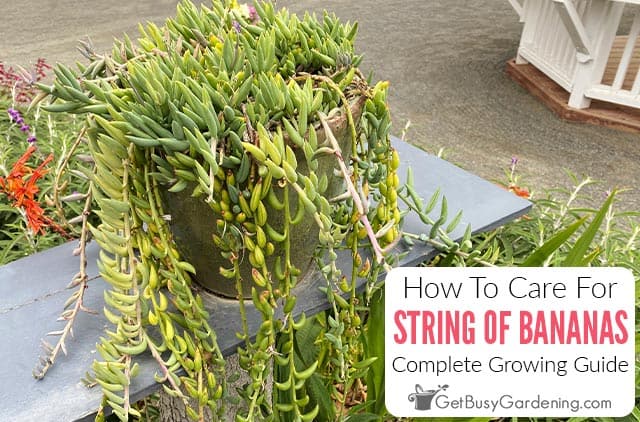

The unique, trailing growth of a string of bananas plant makes them a fun addition to any houseplant collection.
Beginners will be delighted with how easy they can be to grow too.
In this guide about string of bananas plant care, I’ll show you exactly how simple it can be to enjoy them.
Learn all the details about light, soil, and fertilizer, plus how much water, pruning, and other attention they need to thrive.
String Of Bananas Quick Care Overview
| Scientific name: | Curio radicans, Senecio radicans |
| Classification: | Succulent |
| Common names: | String of bananas, banana vine, string of fishhooks |
| Hardiness: | Zones 10-11 |
| Temperature: | 70-80°F |
| Flowers: | White flowers, blooms late winter-early spring |
| Light: | Partial shade |
| Water: | Allow soil to dry between waterings, do not overwater |
| Humidity: | Little to none |
| Fertilizer: | General purpose plant food in spring and summer |
| Soil: | Fast-draining, sandy soil |
| Common pests: | Aphids, mealybugs, scale, spider mites |
Information About String Of Bananas
String of bananas, or Curio radicans (aka Senecio radicans), is a trailing succulent native to South Africa.
It’s often also called banana vine or string of fishhooks. The names refer to the long, thin stems that feature thick, hooked leaves which resemble small green bananas or fishhooks.
They’re popular for draping over hanging baskets, walls, and planters, or used as a ground cover in temperate areas.
The fast-growing vines can reach several feet in length, while the leaves are generally no more than 1-2” long.
Different Types Of Curio radicans
There are many types of trailing, ‘string of’ succulents. Other popular ones, like string of pearls, are often confused with Curio radicans.
They share similar growth habits and care requirements, but the leaves look very different. There’s only one true type of Curio radicans, and it features the discernible curved banana-shaped leaves.
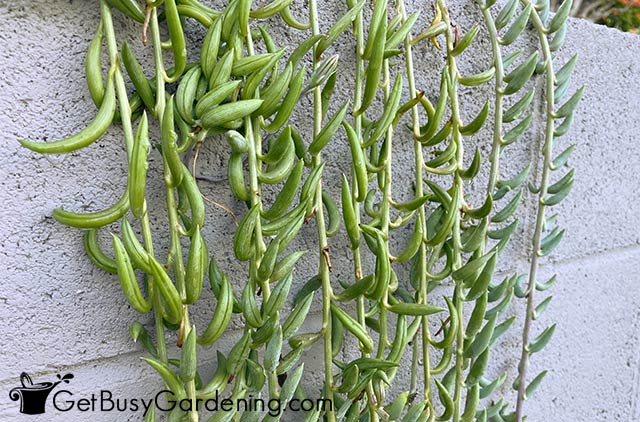
String Of Bananas Flowers
Curio radicans can produce white flowers in the late winter or early spring. They’re small and puffy, and appear in clusters along the stems.
Though insignificant in size, the blooms produce a very pleasant aroma that you can enjoy if you get close enough.
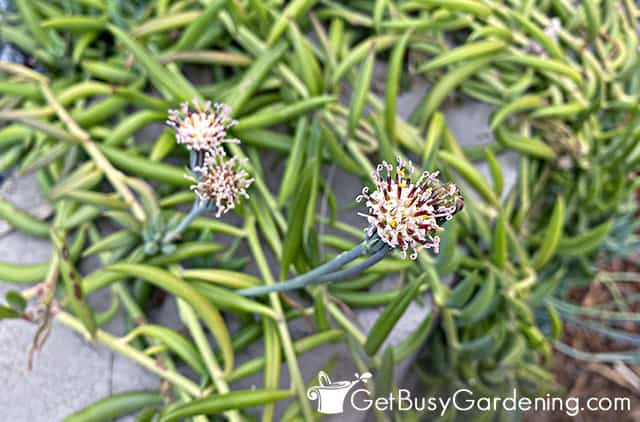
Toxicity
Like many in the Curio family, string of bananas is considered toxic if ingested. You can find out more on the ASPCA website.
But, if you’re worried about it, then I recommend keeping it out of reach of pets and young children.
How To Grow String Of Bananas
Before we talk about the specifics of string of bananas care, let’s chat about the best place to grow them. Choosing a good location can reward you with vigorous healthy vines.
Curio radicans Hardiness
Curio radicans is not a cold hardy plant, and can only be kept outside year around in zones 10-11.
Though they can survive temperatures as low as 30°F, growth will begin to slow, and the foliage can show signs of damage at anything lower than 50°F.
They can also thrive in hotter areas, but will need protection from the intense sun in extremely arid climates.
Where To Grow String Of Bananas Plant
String of bananas can grow outside year round, as long as it’s warm enough for them.
In cooler areas, they need to be kept in containers, and moved indoors before temperatures drop to 50°F.
They make ideal houseplants, and are popular for use in hanging baskets that will showcase the long draping stems.
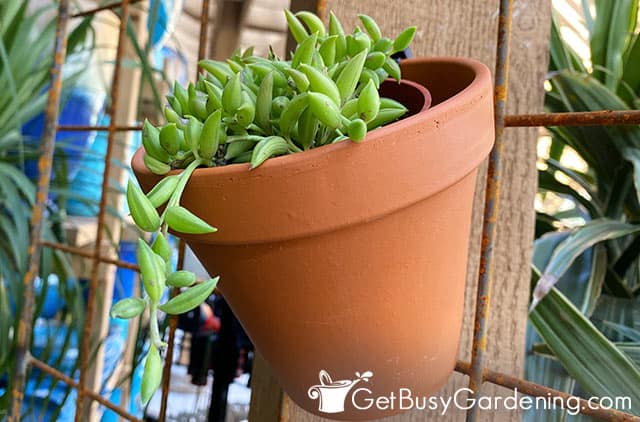
String Of Bananas Care & Growing Instructions
Now that you know where to grow them, let’s talk about how to provide the best string of bananas plant care. With these tips you can keep them healthy and thriving for many years.
Light
Curio radicans need lots of light, but can burn when exposed to direct sun for too long, especially in the hot afternoon rays. So partial shade is ideal outdoors.
Inside, provide at least six hours of bright light to prevent legginess. Direct morning or evening sun through a window is ideal, or add a grow light if your home is too dark.
Water
Though they’re drought tolerant, they will suffer if kept bone-dry for too long. They also don’t like wet feet.
For the best string of bananas care, wait for the top half of the soil to dry out, then water thoroughly.
Always drain off any excess, and never leave the pot sitting in water to avoid issues of rot. An inexpensive moisture probe is an essential tool to help you get it just right.
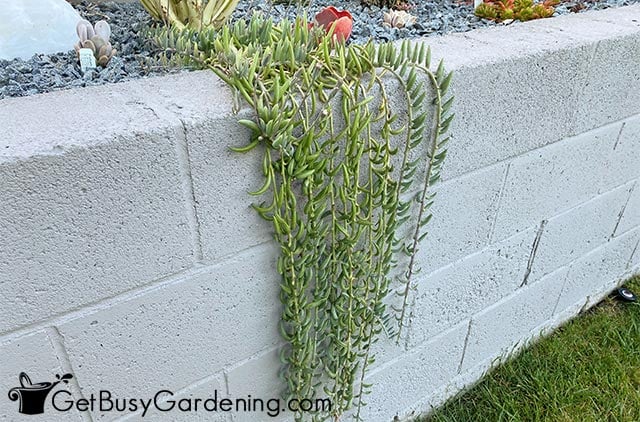
Temperature
There is a wide range of temperatures that Curio radicans can tolerate, but the ideal range is between 70-80°F.
But they can handle extremes down to 30°F without dying, at least for a short time. On the other end of the spectrum, they can tolerate 100°F+, as long as they’re watered frequently and kept shaded.
Fertilizer
Fast-growing string of bananas do best with occasional feedings during the spring and summer months.
Choose organic liquid formulas like compost tea, indoor plant food, or fish emulsion, and apply once a month.
Alternatively, you could use slow-release granules, and apply them once per season. Either way, stop fertilizing altogether in the fall and winter.
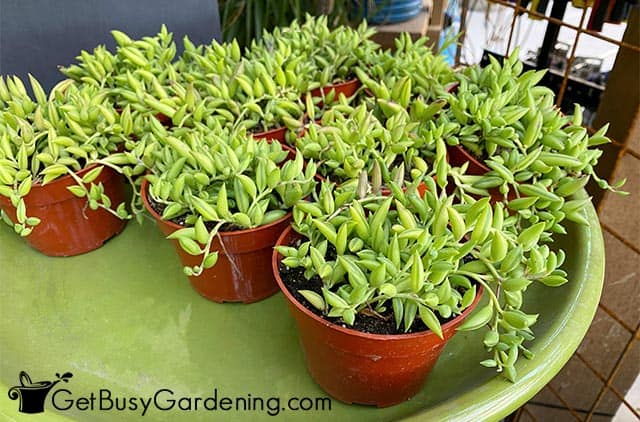
Soil
A fast-draining, coarse, or sandy soil is best for successful string of bananas plant care.
You can use a commercial mix, but it’s ideal to amend it with perlite or pumice to improve the drainage even further.
Repotting
It’s not a good idea to repot Curio radicans frequently. The shallow roots take a while to fill up a container, and they like to be slightly pot-bound.
Wait until they begin to show through the drainage holes, or plant growth has stopped.
Tackle repotting in the spring or summer, and only move them up one pot size to prevent overwatering.
Pruning
The most common reason you’d prune a string of bananas plant is to manage the length of the vines or deadhead the flowers. It’s also a great way to encourage branching.
It’s best to wait until spring or summer, when the plant is actively growing. Use precision pruners or sharp snips to clip the vines at the length you desire.
Two new branches will emerge from the cut, and healthy trimmed sections can be propagated.
Pest Control Tips
On occasion, a string of bananas can become infested with aphids, mealybugs, scale, or spider mites. If you notice any signs of pests, begin treatment immediately.
You can trim off any heavily infested stems right away. Neem oil is great for long-term control, and insecticidal soap can help to get rid of active infestations.
I make my own very easily by combining 1 teaspoon of mild liquid soap with 1 liter of water.
String Of Bananas Propagation Tips
String of bananas can be propagated by seed, but the quickest and most common way is from stem cuttings.
Strip off a few of the bottom leaves, and dip the stems in rooting hormone before placing them in lightly damp soil to root.
Another popular approach is to lay a section of vine across the soil, and gently pin it down. New roots will form all along the stem.
Troubleshooting Common Care Problems
Curio radicans is a fairly trouble-free plant, but you still might run into the occasional problem or two over the years. Use my tips below to help get yours back to health.
Plant Dying At Base
If the plant is dying at the base, it’s usually a sign of improper watering.
Don’t allow the soil to stay bone-dry for too long, but also avoid saturating it to the point of making it wet or soggy.
If the base of the stems have rotted, then it’s best to take healthy cuttings in order to save your plant.
String Of Bananas Growing Upward
When string of bananas grow upward instead of trailing, it’s usually a sign of poor light. In dim settings the leaves will arch toward the nearest light source.
Add a grow light indoors, or move it to a location with more direct morning or evening exposure.
Leaves Turning Brown
Browning or reddish colored leaves are most often caused by sunburn. If you begin to notice brown tips or spots, then move them to a place more protected from direct sun, especially during hot afternoon hours.
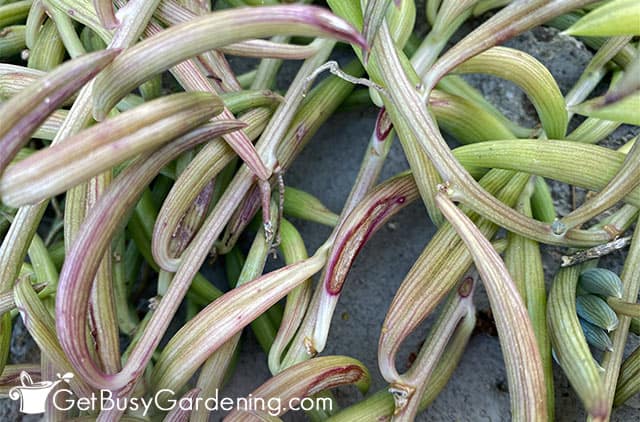
Shriveled Leaves
Wrinkly or shriveled leaves are a clear sign of extreme drought or sudden temperature increases.
Often it means the plant is thirsty and will benefit from a thorough drink. If however you’re experiencing a heat wave, it could be from the temperature swing.
In that case, keep an eye on soil moisture, and provide afternoon shade until temperatures return to normal.
FAQs About String Of Bananas
Here I’ve answered some of the most commonly asked questions about string of bananas plant care. If yours isn’t on the list, please add it to the comments section below.
Is string of bananas rare?
String of bananas are considered rare because they’re less common than other vining succulents. But, you can often find them in the garden center or online without too much difficulty.
Can a string of bananas grow indoors?
Yes, a string of bananas can grow indoors, and they make excellent houseplants when provided enough bright light and adequate water.
How much sun does string of bananas need?
String of bananas needs light to partial shade, rather than full sun. Give them 6+ hours of bright light, but not necessarily direct exposure, every day. Afternoon sun can burn the leaves, so provide shade during those hours.
Is string of bananas easy to grow?
String of bananas is easy to grow, as long as you don’t overwater, and you provide the correct amount of light.
Does string of bananas grow fast?
Yes, string of bananas grow very fast when they’re kept in their ideal environment, and given plenty of light.
How big does string of bananas get?
String of bananas vines can get pretty big, the vines can grow upwards of 3’. They can quickly fill a pot, and will spread over as much area as you give them.
How long do string of bananas take to grow?
How long string of bananas takes to grow depends on the quality of care and the environment, but they can put on several inches every year in ideal conditions.
Now that you know how easy it is to care for the fast-growing string of bananas plant, even a beginner can enjoy Curio radicans for decades with my tips in this guide.
If you want to learn all there is to know about maintaining healthy indoor plants, then you need my Houseplant Care eBook. It will show you everything you need to know about how to keep every plant in your home thriving. Download your copy now!
More Houseplant Care Guides
- How To Care For String Of Hearts (Ceropegia woodii)
- How To Care For Fishbone Cactus (Selenicereus anthonyanus)
- How To Care For Firestick Plant (Euphorbia tirucalli ‘Sticks Of Fire’)
- How To Care For Mother Of Millions Plant (Kalanchoe delagoensis)
- How To Care For Mother Of Thousands Plant (Kalanchoe daigremontiana)
- How To Grow & Care For Echeveria Plants
Share your string of bananas plant care tips in the comments section below.


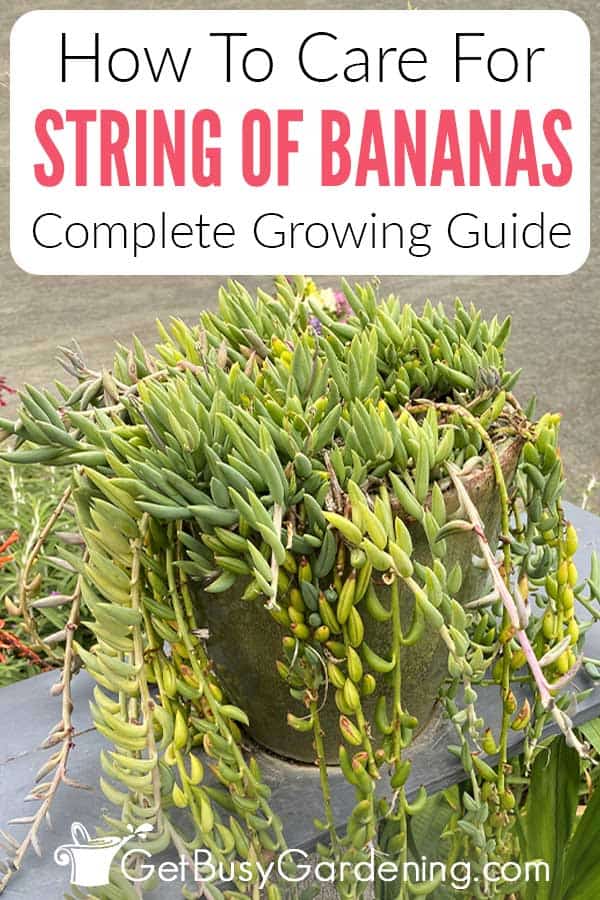



Leave a Reply